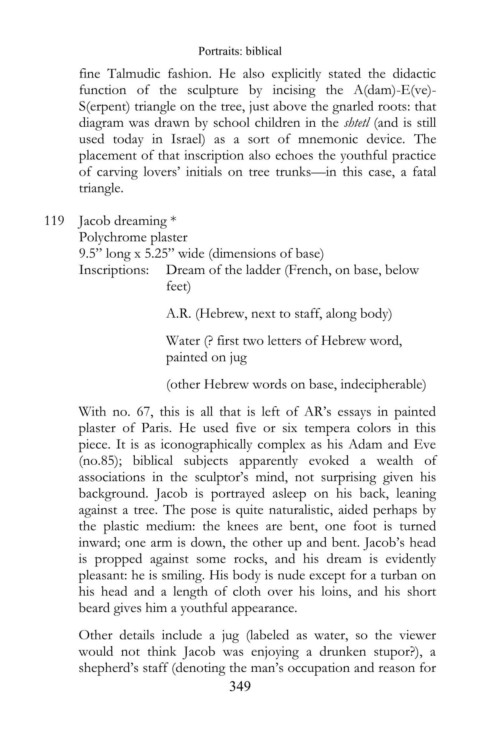Page 353 - The Legacy of Abraham Rothstein - text
P. 353
Portraits: biblical
fine Talmudic fashion. He also explicitly stated the didactic
function of the sculpture by incising the A(dam)-E(ve)-
S(erpent) triangle on the tree, just above the gnarled roots: that
diagram was drawn by school children in the shtetl (and is still
used today in Israel) as a sort of mnemonic device. The
placement of that inscription also echoes the youthful practice
of carving lovers’ initials on tree trunks—in this case, a fatal
triangle.
119 Jacob dreaming *
Polychrome plaster
9.5” long x 5.25” wide (dimensions of base)
Inscriptions: Dream of the ladder (French, on base, below
feet)
A.R. (Hebrew, next to staff, along body)
Water (? first two letters of Hebrew word,
painted on jug
(other Hebrew words on base, indecipherable)
With no. 67, this is all that is left of AR’s essays in painted
plaster of Paris. He used five or six tempera colors in this
piece. It is as iconographically complex as his Adam and Eve
(no.85); biblical subjects apparently evoked a wealth of
associations in the sculptor’s mind, not surprising given his
background. Jacob is portrayed asleep on his back, leaning
against a tree. The pose is quite naturalistic, aided perhaps by
the plastic medium: the knees are bent, one foot is turned
inward; one arm is down, the other up and bent. Jacob’s head
is propped against some rocks, and his dream is evidently
pleasant: he is smiling. His body is nude except for a turban on
his head and a length of cloth over his loins, and his short
beard gives him a youthful appearance.
Other details include a jug (labeled as water, so the viewer
would not think Jacob was enjoying a drunken stupor?), a
shepherd’s staff (denoting the man’s occupation and reason for
349

